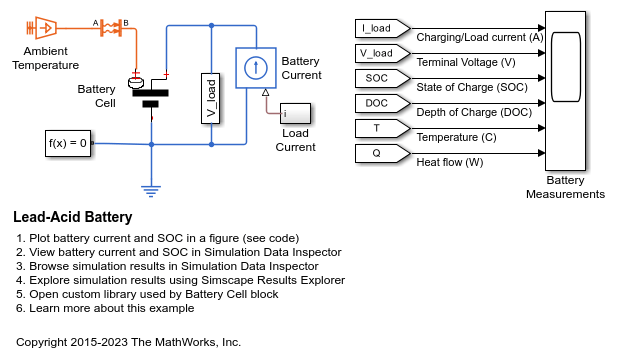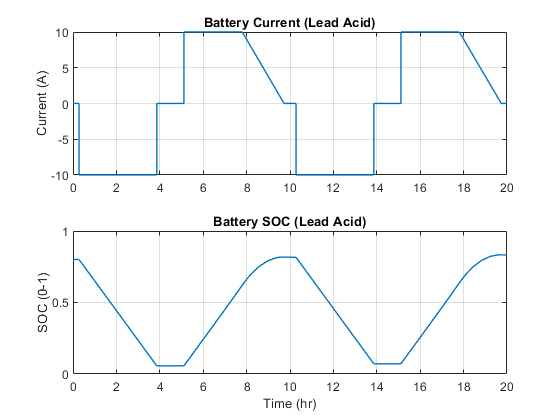铅酸电池
此示例展示了如何使用 Simscape™ 语言对铅酸电池电芯进行建模,以实现等效电路组件的非线性方程。与完全在 Simulink® 中建模相反,这样能更容易理解模型组件和定义物理方程之间的联系。有关定义方程及其验证,请参阅:Jackey, R."A Simple, Effective Lead-Acid Battery Modeling Process for Electrical System Component Selection", SAE World Congress & Exhibition, April 2007, ref.2007-01-0778。
在此仿真中,最初电池以 10A 的恒定电流放电。然后,电池以恒定的 10A 电流充电以回到初始充电状态。随后,电池被放电并再次充电。用一个简单的热模型对电池温度进行建模。假设主要通过对流来冷却,主要通过电池内部电阻 R2 来加热。标准 12 V 铅酸电池可以通过串联连接 6 个 2V 电池电芯模块副本来建模。
此模型是使用 Simscape 示例库 LeadAcidBattery_lib 构造的。该库预置在您的路径上,因此可以轻松执行。但是,建议将源文件复制到您具有写入权限的新目录,并将该目录添加到您的 MATLAB® 路径。这将允许您自己进行更改并重新构建库。示例库的源文件位于以下命名空间目录中: matlabroot/toolbox/physmod/simscape/supporting_files/example_libraries/+LeadAcidBattery,其中 matlabroot 是您计算机上的 MATLAB 根目录,通过在 MATLAB 命令行窗口中输入 matlabroot 可回到此目录。
模型

电池电芯子系统

电池热模型子系统

来自示波器的仿真结果

来自 Simscape 记录的仿真结果
下图显示了 MATLAB 图窗中的电池电流和充电状态。您还可以在 Simscape 结果浏览器和仿真数据检查器中查看数据。
